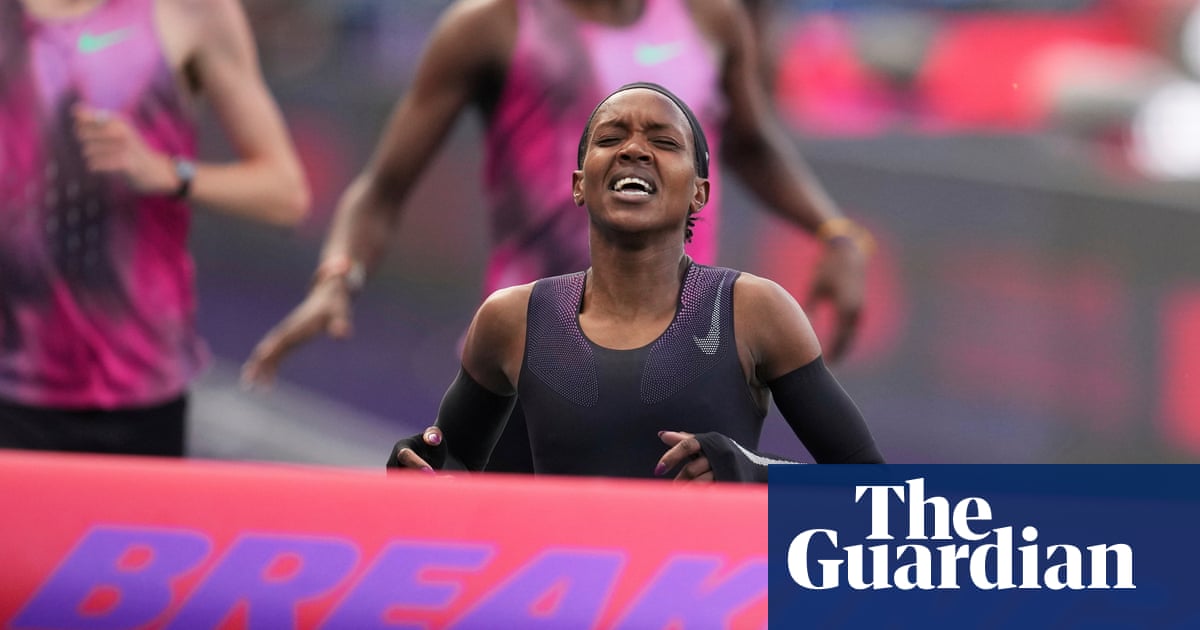Faith Kipyegon’s dream of following in Sir Roger Bannister’s long footsteps by becoming the first woman to shatter the four-minute barrier for the mile ended with her body soaked in lactic acid and defiance. And, crucially, with the stadium clock at Stade Charléty more than six seconds away from where she had hoped it would be.
The 31-year-old Kenyan arrived in Paris stacked with the latest weapons in track and field’s technological arms race. But having reached the bell in 3mins 1sec, just about on schedule, she found that physiology began to overpower technology.
There was a consolation of sorts as she finished in 4:06.42 – 1.22 faster than her world record. The new time will not count as she was being paced by men, which is against WorldAthleticsrules.
“This was the first trial,” she said. “We are learning many lessons from this race. I will go back to the drawing board to get it right. And I think there is more in the tank.”
Before the race Kipyegon’s 13 pacemakers were introduced to the crowd – 11 men and two women. They included several Olympians, the indoor 5,000m world record-holder in the American Grant Fisher, and three Britons, Elliot Giles, Georgia Hunter Bell and Jemma Reekie.
Then it was Kipyegon’s turn, tiny at 5ft 2in, dressed all in black. There was a wave to the crowd, a short sprint to whirr the legs up to full speed. Then they were off, ready to tackle the 1,609 metres in front of them.
It was Giles who led the way, but to the untrained eye it looked as if he went off a little too fast as it took a while to settle into formation: six athletes in a line in front of Kipyegon, one alongside her, and six behind her. The idea was to allow her to draft and reduce wind resistance.
For a while, her supporters in the Stade Charléty dared to dream. Kipyegon went through the first lap in 1:00.20 and hit 800m in 2:00.75. She still looked to be going strong as she heard the bell in 3:01.84, but then the pain and lactic began to rip through her, and she could run the last lap only in a shade under 65 seconds.
The trackside wave lights, which she had used in many of her world records, had been set to get her across the finish line in 3:59.99. This time, though, they kept running further away from her. “I gave everything,” she said. “But I think the wave lights gave everything today too. But maybe next time I can catch up with them.”
Few outside Kipyegon’s camp had expected her to emulate Bannister’s epic 1954 feat. But Nike’s executives insisted privately that there was cause for optimism that she could get close. Part of that came from Kipyegon being armed with the latest super shoes, which were lighter at 90g and more propulsive than her previous spikes. On the insoles were written two words: “fastest known”.
The Kenyan was also wearing a special skinsuit, designed to help her be more aerodynamic. And she had the team of pacers to help her cut through the air quicker.
Sign up toThe Recap
The best of our sports journalism from the past seven days and a heads-up on the weekend’s action
after newsletter promotion
For months an elaborate pacing and drafting strategy was practised in Nike’s headquarters in Oregon and, more recently, in Paris with Britain’s Hunter Bell acting as Kipyegon.
In tests, one Nike athlete had been able to run a mile 3% quicker using such strategy, compared with a test run using normal equipment and with no pacers a fortnight earlier. That gave executives confidence that Kipyegon could go close.
Beforehand they walked around with “I’ve got Faith” T-shirts, with the company’s logo replacing the apostrophe. But faith, it turned out, was not enough. So where does that leave us? The detractors will say it was marketing hype from the beginning. But that isn’t fair. This was a genuine attempt to go where no women had gone before, and Kipyegon should be lauded for rolling the dice and giving it a shot.
At the press conference, she was praised by one influencer for shifting the narrative. But her face showed that she had wanted more. “It was not easy but I wanted to prove to the world that everything is possible in life if you dare to try. I am hoping one day, one time, it will come my way.”
You could only admire her resolve. But finding those seven seconds will not be easy.
